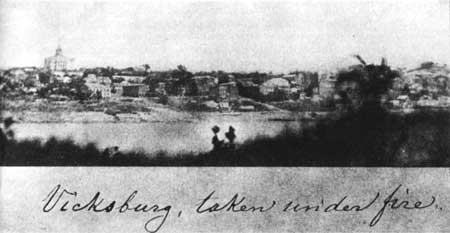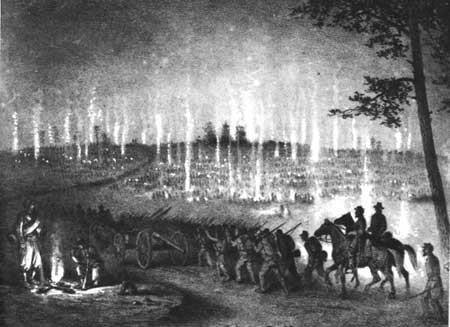|
VICKSBURG National Military Park |
 |

Photograph of Vicksburg taken from across the
Mississippi River by a Union surgeon during a bombardment.
From Photographic History of the Civil War.
The Vicksburg
Campaign: Grant Moves Against Vicksburg— and
Succeeds (continued)
THE BATTLES OF RAYMOND AND JACKSON. When it became likely that Grant might strike the railroad in the vicinity of Edwards Station, Pemberton moved from Vicksburg toward that point with his main force, leaving a strong reserve in this city. At the same time he ordered the units collecting at Jackson to hit Grant's flank and rear if the opportunity presented itself. Maj. Gen. John A. Logan's Division, in advance of McPherson's Union Corps, reached the vicinity of Raymond, a crossroads village 15 miles from Jackson on May 12, and was there engaged by a Confederate brigade under Brig. Gen. John Gregg. A sharp clash lasting several hours followed, Gregg's outmanned infantry being driven back toward Jackson. Each side lost about 500 men during the engagement. Confederate resistance at Raymond indicated to Grant that Jackson might be held more strongly than had been anticipated, and rumors reached the Union Commander that strong reinforcements under Johnston were expected there. Grant then determined to make sure of Jackson and, on May 13, wheeled his entire army toward the east.
Johnston arrived by rail in Jackson, on the night of the Raymond engagement, in order to take field command of all troops defending Vicksburg, and was notified that Grant's Army was between Pemberton's forces and those in Jackson. About 12,000 troops were at Jackson, against which the entire Union Army was reported to be moving. Johnston telegraphed Richmond, "I am too late."

Troops on the march, going into bivouac at night.
From a wartime sketch.
In a pouring rain, Sherman and McPherson approached Jackson on the morning of May 14. Johnston posted the brigades of General Gregg and Brig. Gen. W. H. T. Walker on the approaches to the city with instructions to hold just long enough for valuable stores to be removed from Jackson northward to Canton where he hoped to combine forces with Pemberton. Delaying their attack until the rain (which would spoil their powder) slackened, the Union infantry charged the Confederate entrenchments, driving the defenders before them and capturing the city along with 35 guns and much equipment. Having intercepted a dispatch from Johnston to Pemberton ordering a junction of all Confederate troops, Grant put his men on the road toward Edwards Station at daylight the following morning. His plan was to drive a wedge between the Confederate forces before Johnston, circling to the north, could effect a junction with Pemberton. Sherman remained in Jackson to destroy the railroad yards and stores.

|
|
Last Modified: Mon, Dec 2 2002 10:00:00 am PDT |


